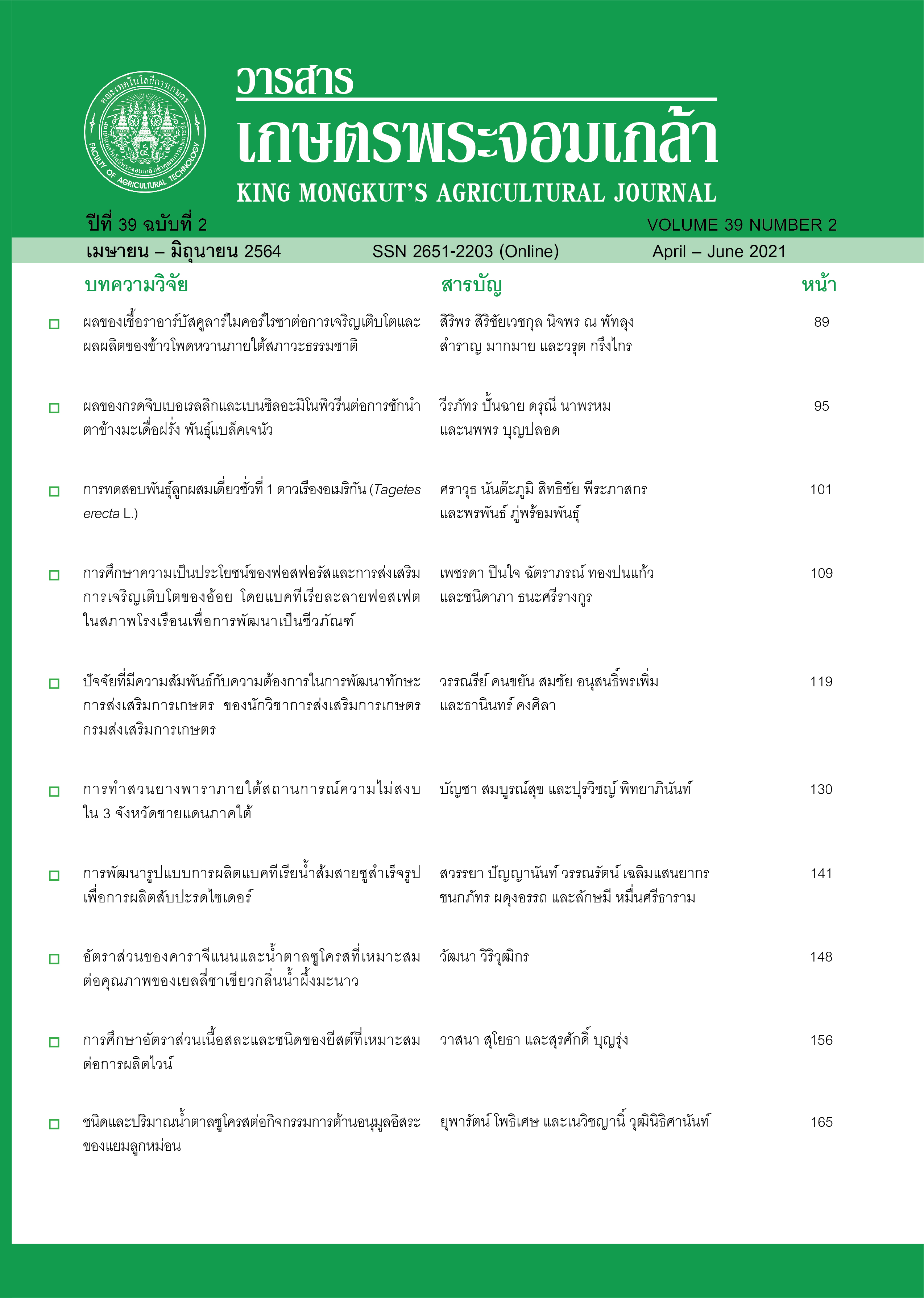ชนิดและปริมาณน้ำตาลซูโครสต่อกิจกรรมการต้านอนุมูลอิสระของแยมลูกหม่อน
Main Article Content
บทคัดย่อ
วัตถุประสงค์ของงานวิจัยนี้เพื่อศึกษาผลของชนิดและปริมาณน้ำตาลซูโครสในการผลิตแยมลูกหม่อน 5 สูตร ต่อกิจกรรมการต้านอนุมูลอิสระ และคะแนนความชอบโดยการประเมินทางประสาทสัมผัส โดยแยมลูกหม่อนทั้ง 5 สูตร ได้แก่สูตรไม่เติมน้ำตาล (สูตรที่ 1) สูตรที่เติมน้ำตาลทรายขาว 510 กรัม (43.81%) (สูตรที่ 2) สูตรที่เติมน้ำตาลทรายแดง 510 กรัม (43.81%) (สูตรที่ 3) สูตรที่เติมน้ำตาลทรายขาว 255 กรัม (28.17%) (สูตรที่ 4) และสูตรที่เติมน้ำตาลทรายแดง 255 กรัม (28.17%) (สูตรที่ 5) ผลการทดลองพบว่า ปริมาณสารประกอบฟีนอลิกทั้งหมดมีค่ามากที่สุดในแยมลูกหม่อนสูตรที่ 4 และ สูตรที่ 5 อย่างมีนัยสำคัญ (P<0.05) โดยสูตรที่ 5 มีค่ากิจกรรมการต้านอนุมูลอิสระมากที่สุด การประเมินทางประสาทสัมผัสโดยใช้แบบทดสอบความชอบ 7 ระดับ พบว่าผู้ทดสอบให้คะแนนการยอมรับแยมลูกหม่อนสูตรที่ 4 และ 5 มากที่สุด ดังนั้นการเลือกใช้น้ำตาลทรายแดง 255 กรัม (ลดน้ำตาล 50%) เป็นสูตรเหมาะสมในการผลิตแยมลูกหม่อนเพื่อเป็นข้อมูลสำหรับการพัฒนาการผลิตแยมลูกหม่อนในเชิงพาณิชย์ต่อไป
Article Details
วารสารเกษตรพระจอมเกล้า
เอกสารอ้างอิง
กระทรวงสาธารณสุข. 2543. แยม เยลลี่และมาร์มาเลต. นนทบุรี: สำนักงานอาหารและยา กระทรวงสาธารณสุข.
เนตรนภา อุ่นทิ และฉัตรภา หัตถโกศล. 2562. ประโยชน์ต่อสุขภาพของผลไม้ตระกูลเบอรีที่ปลูกได้ในประเทศไทย. วารสารโภชนาการ 54(2): 94-105.
มนัญญา คำวิชระพิทักษ์, พะยอม รอดเล็ก, มรกต กิจเจา, สุวิชญา สิงห์ทอง, เบญจางค์ อัจฉริยะโพธา, จุฑารัตน์ พงษ์โนรี, กนกวรรณ ปุณณะตระกูล และคณะ. 2559. ผลของสารให้ความหวานฟรุกโตสไซรัปและซูคราโลสที่มีผลต่อคุณลักษณะบางประการของแยมผลไม้ผสม.
วารสารวิจัยและพัฒนา วไลยอลงกรณ์ในพระบรมราชูปถัมภ์ 11(2): 16-23.
ลือชัย บุตคุป. 2555. การศึกษาเปรียบเทียบปริมาณฟลาโวนอยด์และฤทธิ์การต้านออกซิเดชันในผลหม่อนสายพันธุ์ต่าง ๆ. วารสารวิจัยเพื่อชุมชน มหาวิทยาลัยมหาสารคาม 1(2): 31-47.
วัชราวุธ ศรีสุธรรม. 2553. อาหารเพื่อมนุษยชาติ. กรุงเทพฯ: มหาวิทยาลัยเกษตรศาสตร์.
AOAC. 2005. Official method of analysis of AOAC international. 17th ed. Horwitz, Willium: Association of Official Analytical Chemists. Inc.
Aydin, E., and Gocmen, D. 2015. The influences of drying method and metabisulfite pre-treatment on color, functional properties and phenolic acids contents and bioaccessibitiy of pumpkin flour. LWT-Food Science and Technology 60: 385-392.
Claudin, M., Andrzej, M., and Augustia, S. 2005. Polyphenols and prevention of cardiovascular disease.
Current Opinion in Lipidology 16: 77-84
Duthie, G. G., Duthie, S. J., and Kyle, J. A. M. 2000. Plant polyphenols in cancer and heart disease: implications as nutritional antioxidants. Nutrition Research Reviews 13: 79-106.
Howard, L. R., Castrodale, C., Brownmiller, C., and Mauromoustakos, A. 2010. Jam processing and storage effects on blueberry polyphenolics and antioxidant capacity. Journal of Agriculture and Food Chemistry 25: 4022-4029.
Igual, M., Garcia-Martinez, E., Camacho, M. M., and Martinez-Navarrete, N. 2013. Jam processing and storage effects on ß-carotene and flavonoids content in grapefruit. Journal of Functional Foods 5: 736-744.
Kamiloglu, S., Pasli, A. A., Ozcelik, B., Camp, J. V., and Capanoglu, E. 2015. Influence of different processing and storage conditions on in vitro bioaccessibility of polyphenols in black carrot jams and marmalades. Food Chemistry 186: 74-82.
Lazee, M. C., Savio, M., Pizzala, R., Cazzalini, O., Perucca, P., Scovassi, A. I., Stivala, L. A., and Bianchi, L. 2004.
Anthocyanins induce cell cycle perturbations and apoptosis in different human cell lines. Carcinogenesis 25: 1427-1433.
Patras, A., Brunton, N., and Tiwari, B. K. 2011. Stability and degradation kinetics of bioactive compounds and color in strawberry jam during storage. Food Bioprocess Technology 4: 1245-1252.
Rababah, T. M., Al-Mahasneh, M. A., Kilani, I., Yang, W., Nlhamad, M. N., Ereifej, K., Al-udatt, M. et al. 2010. Effect of jam processing and storage on total phenolics, antioxidant activity, and anthocyanins of different fruits. Journal of the Science of Food Agriculture 91: 1096-1102.
Radojkovic, M. M., Zekovic, Z. P., Vidovic, S. S., Kocar, D. D., Pavle, Z., and Maskovic, P. 2012. Free radical scavenging activity and total phenolic and flavonoid contents of mulberry (Morus spp. L., Moraceae) extracts. Hemijska Industrija 66: 547-552.
Schmidt, B. M., Erdman, J. W., and Lila, M. A. 2005. Effects of food processing on blueberry antiproliferation and antioxidant activity. Journal of Food Science 70: s389-s394.
Teangpook, C., and Paosantong, U. 2013. Production and shelf-life of low sucrose lime juice papaya jam. Pakistan Journal of Nutrition 12(9): 870-878.
Yang, X., Yang, L., and Zheng, H. 2010. Hyperlipidemia and antioxidant effects of mulberry (Morus alba L.) fruit in hyperlipidemia rats. Food and Chemical Toxicology 48: 2374-2378.


